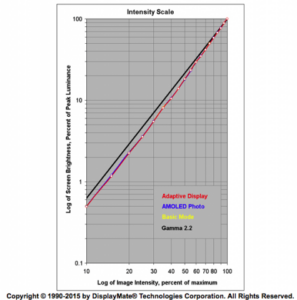In the OLED Display Technology Shoot-out published today, Displaymate Labs said Samsung once again has leapfrogged its generational OLED display performance with its new flagship flexible curved screen Galaxy S6 Edge and Galaxy S6 2.5K QHD smartphone displays.
Samsung Galaxy S6 Image Contrast and Intensity Scales closely match the standard Gamma 2.2 scale as illustrated here. Source: DisplayMate.com This remarkable display performance using a flexible curved surface places Samsung at the new cutting edge with its breakthrough technology. Both devices were announced at the Mobile World Congress in Barcelona Spain on March 1st. Displaymate founder and chief researcher Dr. Ray Soneira called the Display the ‘crown jewel’ of the smartphone, stating Samsung has “…systematically improved it’s OLED display performance twice a year with each Galaxy generation since 2010, including many significant improvements over the Galaxy S5”.
By the numbers, Shoot-out improvements were found in five key areas: (1) increased pixels per inch (577 ppi) and higher pixel resolution (3.7 megapixel), (2) higher absolute color accuracy (27% increase), (3) peak brightness (up 12%), (4) contrast and screen readability in high ambient light (up 10%), (5) display power efficiency (up 20%).
The most notable breakthrough from the Samsung new OLED display offering is its remarkable performance on a flexible plastic substrate in the curved Galaxy S6 Edge screen. Soneira reported the performance measurements on flex backplane “…is now essentially the same as on a traditional flat and hard substrate for the Galaxy S6, even at 500+ pixels per inch and 2560 x 1440 resolution,” he said in the report.
On the mobile side, Soneira calls the flexible Edge display an important user interface enhancement that started with Samsung’s Galaxy Round, a curved display with improved image contrast and reduced screen reflectance. The previous generation Note Edge offered a single sided curve (on the right side of the display) and experimented with user interface cues that also added a fun new way to access information while the main display was not being viewed. This third generation dual edge OLED display in the Galaxy S6 is curved on both sides and activated only when the main display is off. Soneira notes that while it is made rigid by the existing Gorilla Glass, he expects that to change over time, as the backplane is currently able to dynamically flex. He also emphasized the impact of the breakthrough stating, “…curved and flexible displays are definitely the wave of the future because they offer many important visual and functional advantages for both mobile displays and TVs”.
Also notable is the new OLED display’s screen brightness and performance in high ambient light. Soneira reports Samsung delivers both low screen reflectance (4.6%) and high screen brightness (432 cd/m²) under high ambient lighting conditions. “That screen reflectance is closest to the lowest that we’ve ever measured for a Smartphone,” Soneira said in his initial shoot-out findings that went live today. Further, the measured screen visibility under high ambient light yields a contrast rating from 118 to 170, again pushing the boundaries calling it “the best mobile display we have ever tested” according to the Displaymate findings. Be sure to see the complete OLED Display Shoot-out report on Displaymate.com
Impressive Systematic Improvements
Samsung has consistently made incremental improvements in its OLED display technology since the first Google Nexus One shipped in 2010, starting at the bottom of the display quality heap. But the company has demonstrated its commitment to mobile OLED technology first reaching parity with LCD and now exceeding its rival technology in many display metrics over the course of the past five years.
We agree with Soneira’s assessment that the display is the crown jewel of smartphones, and would go beyond to include most of any handheld or wearable device. And while most would agree that flexible display are the future of the industry, we find the new Samsung Galaxy Edge 6 also (and significantly) at the cutting-edge of display performance, with the added benefit of being made on a flexible substrate. This could prove to give Samsung the advantage it needs to develop new breakthrough devices going forward, particularly as the next wave of wearables begins to hit the market. – Steve Sechrist


